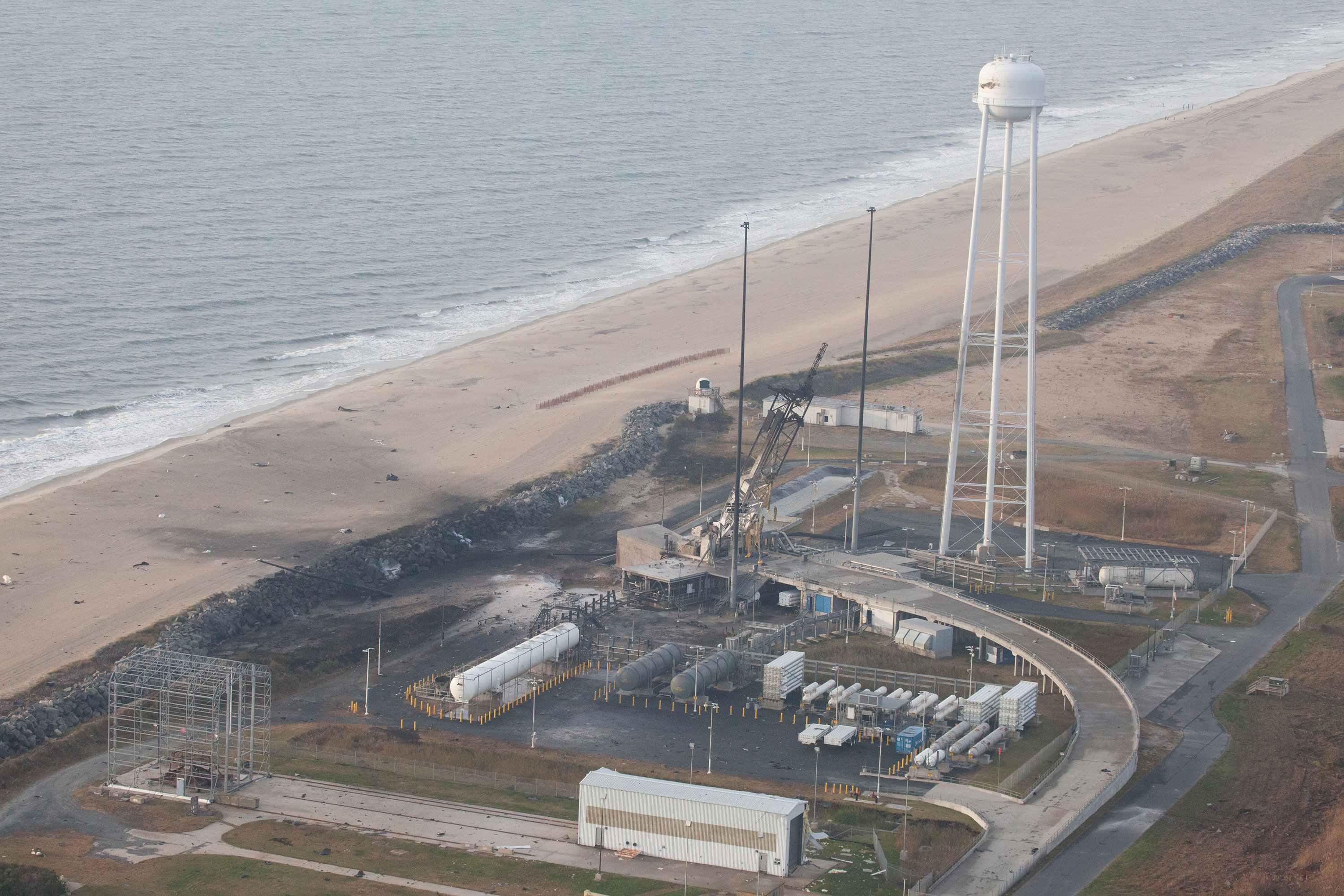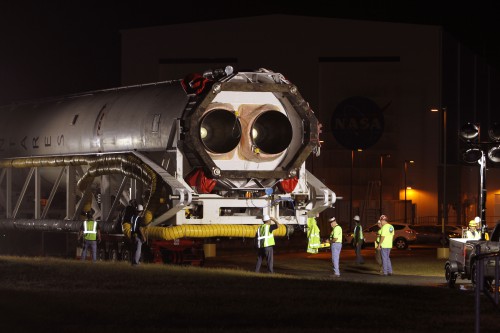
One week after the catastrophic explosion of its fifth Antares booster—which lost all forward momentum and was remotely destroyed by the Range Safety Officer (RSO) seconds after liftoff from Pad 0A at the Mid-Atlantic Regional Spaceport (MARS) on Wallops Island, Va.—Orbital Sciences Corp. has announced comprehensive plans to fulfil its contractual obligations to NASA. Under the language of the $1.9 billion Commercial Resupply Services (CRS) contract, signed back in December 2008, Orbital is committed to staging eight dedicated Cygnus cargo missions and delivering 44,000 pounds (20,000 kg) of supplies to the International Space Station (ISS). Last week’s mission was carrying the third dedicated Cygnus, and its failure resulted in the loss of around 5,050 pounds (2,290 kg) of experiments, tools, equipment, and consumables for the incumbent Expedition 41 crew.
In spite of the apparently apocalyptic nature of the explosion, it proved remarkable not only that no human injuries were sustained on the ground, but also that the Pad 0A complex survived significant structural damage. As described by AmericaSpace’s Mike Killian, an Incident Response Team (IRT) from NASA’s Wallops Flight Facility conducted an initial inspection on Wednesday, 29 October, which revealed damage to nearby support buildings—including broken windows and imploded doors—as well as to lightning suppression rods and the charred and blackened Transporter-Erector-Launcher (TEL). The latter is used to roll the Antares booster from the Horizontal Integration Facility (HIF) to Pad 0A, elevate it to a vertical configuration, and provide a support gantry. “There is some evidence of damage to piping that runs between the fuel and commodity storage vessels and the launch mount,” Orbital noted, “but no evidence of significant damage to either the storage vessels or launch mount.” Air sampling at the Wallops mainland area, the Highway 175 causeway and on Chincoteague Island revealed no hazardous substances and no damage to local wildlife. Moreover, the majority of the destruction appeared to be contained within the southern third of Wallops Island, close to the pad itself.

Today (Wednesday, 5 November), Orbital Sciences announced not only that it will complete all remaining Cygnus cargo missions by the end of 2016, but that it will also accelerate the development of an upgrade to the Antares booster’s main propulsion system. The Dulles, Va.-based company has its own Accident Investigation Board (AIB) on the scene at Wallops and is reportedly “making good progress” in determining the primary cause of the failure. “A preliminary review of telemetry and video data has been conducted and substantial debris from the Antares rocket and its Cygnus payload has been collected and examined,” it was revealed. “While the work of the AIB continues, preliminary evidence and analysis conducted to date points to a probable turbopump-related failure in one of the two Aerojet Rocketdyne AJ-26 stage one main engines. As a result, the use of these engines for the Antares vehicle likely will be discontinued.”
The heritage of this Russian-built engine extends back to the Soviet era, having originated as the NK-33 powerplant for the ill-fated N-1 lunar superbooster, which spectacularly failed in all four of its launch attempts between February 1969 and November 1972. It is fed by a combination of liquid oxygen and a refined form of rocket-grade kerosene, known as “RP-1.” Thirty-six of the engines were procured from Russia in the mid-1990s, at a reported cost of $1.1 million per unit, to which Aerojet and Orbital Sciences have added modern electronics and other performance enhancements. At the instant of liftoff, the two AJ-26 engines produce a total sea-level propulsive yield of 734,000 pounds (332,930 kg), powering the Antares vehicle for the first four minutes of its flight.
The AJ-26 performed well on the test stand in 2010, although one of them caught fire in June 2011, following a kerosene leak, apparently induced by stress corrosion cracking in the 40-year-old metal. After these and other headaches, the first Antares roared into orbit in April 2013, followed by a demonstration (ORB-D) flight of Cygnus in September 2013 and the first two dedicated resupply missions in January (ORB-1) and July (ORB-2) of this year. On all four missions, the AJ-26 performed without incident. Then, in May 2014, an engine earmarked for one of 2015’s Antares launches exploded on the test stand at NASA’s Stennis Space Center in Hancock County, Miss. It remains to be seen if this incident and last week’s Antares failure are linked or representative of a systemic flaw.

Aerojet had already agreed to recondition sufficient AJ-26 engines to cover all Antares-Cygnus missions through 2016. However, Orbital’s vice president for Public Relations, Barron Beneski, revealed last month in an interview with the Russian news agency, Tass, that the RD-193 engine—also fueled by a mixture of liquid oxygen and RP-1—would likely form the core of a next-generation Antares. “To maintain the CRS program’s critical ISS supply line, Orbital plans an early introduction of its previously selected Antares propulsion system upgrade in 2016,” the company reported. “This will be preceded by one or two non-Antares launches of the company’s’ Cygnus cargo spacecraft to the ISS in 2015-2016, employing the spacecraft’s compatibility with various launch vehicles and its flexibility to accommodate heavier cargo loads as launcher capacity permits.” A resumption of Antares operations, with the upgraded engine system, is anticipated “in 2016.”
“Orbital is taking decisive action to fulfill our commitments to NASA in support of safe and productive operations of the Space Station,” said David Thompson, Orbital’s Chairman and Chief Executive Officer. “While last week’s Antares failure was very disappointing to all of us, the company is already implementing a contingency plan to overcome this setback. We intend to move forward safely but also expeditiously to put our CRS cargo program back on track and to accelerate the introduction of our upgraded Antares rocket. Exact financial impacts to Orbital will depend on which of several specific options for near-term launches is selected, but they are not expected to be material on an annual basis in 2015. In all cases, no significant adverse effects are projected in 2016 or future years, in part because the cost of the Antares propulsion system upgrade was already part of our internal investment plan during that time.”
Want to keep up-to-date with all things space? Be sure to “Like” AmericaSpace on Facebook and follow us on Twitter: @AmericaSpace



